TechByter's New Look: Wider and Without Tables
Each year in January, I revise the look of the website. This year's revision is wider, reflecting the continuing trend toward higher screen resolution. Not long ago, we were pushing the envelope to create a website that required a monitor with a width of at least 800 pixels. Today nearly everyone has a screen that displays at least 1024 pixels (wide) and 1600 pixel widths, which were once territories occupied only by Sun workstations and other high-end gear, are increasingly common. In 2007, I expanded TechByter Worldwide's screen to 650 pixels. This year, it's 800. But that's just the beginning.
The larger change is the one that eliminates tables. Tables have been misused for years as a formatting tool because they allow relatively precise positioning of test and graphics. When you look at the website, you don't see the tables and they keep the information in order. What could be wrong with tables?
Tables are not a problem for those who can see the page. But not everyone can see. Those who have impaired vision and those who are blind visit the TechByter Worldwide website by using a special program that reads the text. Tables are an astonishing impediment to those who depend on readers to extract the content of a Web page. So this year I have taken the "bold" move (3 or 4 years ago, it might really have been bold) of discarding tables and using cascading style sheets with positioning (CSS-P) to control the formatting.
I thought seriously about doing this in 2007 and considered it in 2006. But I chickened out both times because CSS-P wasn't supported well by older browsers. Because not everyone upgrades to the latest available browser, I held back.
Is there a problem with this page?
If you are having a problem viewing this page, I'm sorry, but that means that you're using what can only be called an antique, outmoded browser. Download a current version of Internet Explorer (anything from version 5.5 on should work) or Firefox or Opera. At some point, website designers must assume that visitors are using a browser that was developed in the current century.
Please download a current browser. Here are some that are current (version dates as of late November 2007):
- Microsoft Internet Explorer (XP and Vista: v. 7; other Windows users: v. 6; the latest Mac version is v. 5.2, which has some display problems, but few Mac owners use IE)
- Firefox (v. 2.0.0.9 for Windows, Mac, and Linux)
- Netscape (v. 9.0.0.3 for Windows, Mac, and Linux; based on Gecko)
- Opera (v. 9.2.4 for Windows, Mac, and Linux)
- Safari (v. 3-beta for Mac and Windows; not recommended for Windows)
- Flock (v. 1.0 for Windows, Mac, and Linux; not tested, but based on Gecko)
- Sunrise (v. 1.5.4 at this writing for Mac OSX only, universal binary; not tested)
- Camino (v. 1.5.3 for Mac OSX only; not tested, but based on Gecko)
- Amaya (v. 9.99-3 by the W3C project for Windows, Mac, and Linux; browser and editor)
- Avant (v. 11.5-21 for Windows; uses Microsoft IE rendering engine)
- And many others ....
Plug and What?
When version 1.0 of the USB specification was shown at PC Expo in New York City sometime in the '90s, there was a clear promise that peripherals would be easy to attach and detach from a computer. Version 1.0 was never released to the public, but version 1.1 was. "Plug-and-Pray" is what a lot of people called USB in those days. People who I considered smarter than me openly derided the USB spec and said it would never work. It seems that, for the most part, I called that one right.
Today I have a computer with 5 disk drives: 2 are internal and 3 are external USB 2.0 devices. I also routinely plug in USB 2.0 thumb drives and a digital camera card reader. My scanner is a USB 2.0 device. The mouse is a USB 2.0 device. The keyboard could be, but the one I own has a PS/2 connector on it. And recently I bought a laser printer that has only a USB interface. No serial. No parallel. No network. Just USB 2.0.
So I followed the instructions and inserted the CD before I plugged in the printer. New hardware, the computer told me and then it offered to install the printer. It found the CD but Vista failed to install it. This is Vista, after all; Microsoft's secure operating system. So I shut down the printer, closed the automatic installation wizard, and ran the CD-based installer as the Administrator. The driver installed. I turned the printer on. Vista discovered it and found the drivers.
In less than 10 minutes, I had a new operating printer. And I hadn't shed a prayer.
No matter what you buy for your computer today, it's probably going to be a USB device. Today's computers don't include serial ports (1970s technology) or parallel ports (big hits in the 1980s). Whether it's a mouse, a keyboard, a scanner, a printer, or a portable disk drive, it's probably a USB device.
It's good to be right, at least occasionally.
And Another Thing ...
In the early 1980s, when HP "invented" the laser printer, the devices weighed about 30 pounds, cost $3500, and had a single built-in typeface: Courier.
In truth, it was Xerox that invented the laser printer. At the Palo Alto Research Center (PARC), a facility that was responsible, directly or indirectly, for many components that are essential to the Internet, the graphical user interface, the mouse, desktop computers, and notebook computers. Xerox invented a lot of today's technologies at PARC, but rarely managed to capitalize on them. PARC did manage to make money for Xerox — a lot of money — by licensing laser printer technology to Hewlett-Packard.
As for the new laser printer, it's rated at 15 pages per minute at 600-dpi resolution. HP's resolution enhancement (REt) and FastRes boost the "effective" resolution to 1200-dpi. List price is $180, but I obtained the printer from NewEgg.com for just $109, shipping included.
So today's $100 printer is far more capable than a $3500 printer from 20 years ago. Wow.
Spoiling your Fun
Recently, I received a link to a "guess your number" site with a question about how it works. Visitors are shown the numbers 1 through 25 in a 5x5 matrix. Each of the numbers is displayed in one of 5 colors. I'm asked to click the color of my number. A couple of steps later, the same 25 numbers are repeated using the same colors, but now they're grouped into "houses". I'm supposed to click the house my number lives in. And a couple of steps later, I'm shown 3 doors and told to click one to see my number. And it always works! Imagine that.
There is, of course, no magic involved. The computer can't read my mind. The person who wrote the program doesn't have some kind of superhuman psychological skills. I told the program exactly which number I selected. No luck. No chance. No guess work. Let's take it step-by step.
Click any of the images for a larger view.
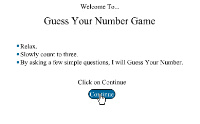 Screen 1: Setting up the sucker.
Screen 1: Setting up the sucker.
In a con game, there's usually an elaborate setup. This isn't particularly elaborate, but it serves the same purpose. The programmer reinforces that the program will guess my number.
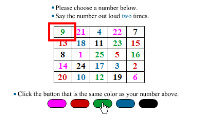 Screen 2: Telling the program your number (step 1).
Screen 2: Telling the program your number (step 1).
Here's the matrix, 5 across and 5 down for a total of 25 numbers. Each number is one of 5 colors. I'm going to pick 9, which is green, so I click the green oval.
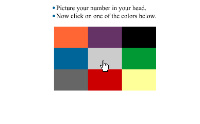 Screen 3: Obfuscation page #1.
Screen 3: Obfuscation page #1.
A magician would call this misdirection. Here's a 3x3 matrix that includes some of the colors from the previous page, but some have been added and some are missing. I'm supposed to click one of the colors. I'm supposed to think that this means something. It means nothing.
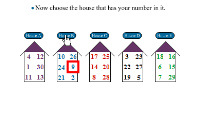 Screen 4: Telling the program your number (step 2).
Screen 4: Telling the program your number (step 2).
Now the numbers are arranged in little houses. The colors are the same as on the first selection screen, but notice that 9 is in the blue house and is now shown in blue. Because the colors are the same as they were 2 screens ago, even though most of the numbers are now presented in different colors, I'm not supposed to notice this.
Now the program has everything it needs to identify my number because every number may be identified in a matrix that includes the color (mine is green) and the house (mine is B). If you examine screens 2 and 4, you will see that one and only one number is both green and B. That number is 9. Every other number shown has exactly one set of color-house coordinates.
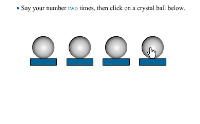 Screen 5: Obfuscation page #2.
Screen 5: Obfuscation page #2.
The program already knows my number and could show it to me now, but additional misdirection is needed to distract me. Here are 4 identical symbols ("crystal balls"). It doesn't matter which I click.
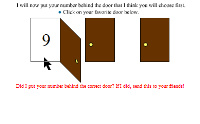 Screen 6a: Revealing the number.
Screen 6a: Revealing the number.
Now I'm standing in front of 3 doors. It doesn't matter which door I click first: The program will put my number "behind" that door. These doors aren't real and the program can display whatever it wants when I click. If I erroneously apply physical (real-world) thinking to virtual space, I could believe that something supernatural is going on here.
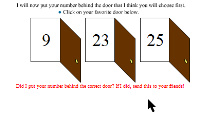 Screen 6b: Driving the point home.
Screen 6b: Driving the point home.
If I decide to click the other doors, I will see other numbers. This reinforces the point that this was not a "trick" by implying that if I had only clicked the middle door or the right door instead of the left door, I would have fooled the program. Nothing could be further from the truth.
It's essentially an updated, automated Internet version of the old shell game. If you want to play it yourself, you'll find this game here. It's safe enough to play because there's no wagering involved, but if you're ever tempted to visit an on-line casino (or to play the shell game or three-card monte on the street) keep this in mind.
Stupid Spam of the Week
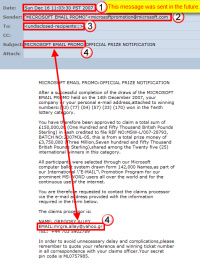 Spammers clearly think that the people they send messages to are none too bright and in some cases they're probably right. Take this week's example as a case in point. According to the timestamp in the message, I received it well over an hour before it was sent. But that's just the start.
Spammers clearly think that the people they send messages to are none too bright and in some cases they're probably right. Take this week's example as a case in point. According to the timestamp in the message, I received it well over an hour before it was sent. But that's just the start.
To see a larger view of the spam, just click the image at the right.
I spotted 4 dead giveaways in about as many seconds. I've already mentioned the first: The message arrived before it claims to have been sent. That's a typical spammer trick and a forged date is enough for me to discard the message without going further. But I went further.
Point 2: The sender's address is malformed.
Point 3: "Undisclosed recipients" means that the writer blasted out a message using the BCC function. Given that there are just 25 "winners", don't you think each might receive a personal message? After all, the "prize" is 150,000GBP.
Point 3a: The prize is in British pounds. Microsoft is based in the United States. Might a reasonable person expect a prize being paid by a US company to a US citizen would be paid in US dollars?
Point 4: Although this is a "Microsoft E-mail Promo", the "winner" is supposed to contact someone with a Yahoo e-mail address. At the end of the address, the letters "gr" mean that this is Yahoo in Greece. So a US company is notifying a US citizen about a prize to be paid in British pounds and the "winner" is supposed to call either a British phone number or write to a Greek e-mail address.
Additional points (if required) can easily be identified by examining the spelling, spacing, syntax, punctuation, and capitalization in the message.
Needless to say, I did not attempt to contact Mrs. Veronica Philips.
MICROSOFT EMAIL PROMO:OFFICIAL PRIZE NOTIFICATION
After a successful completion of the draws of the MICROSOFT
EMAIL PROMO held on the 14th December 2007, your
company or your personal e-mail address,attached to winning
numbers:(23) (77) (04) (57) (33) (170) won in the Tenth
lottery category.
You have therefore been approved to claim a total sum of
£150,000,00 (One Hundred and Fifty Thousand British Pounds
Sterling) in cash credited to file REF NO:MSW-L/007-28793,
BATCH NO:2007MJL-05, this is from a total prize money of
£3,750,000 (Three Million,Seven hundred and Fifty Thousand
British Pounds Sterling),shared among the Twenty five (25)
international winners in this category.
All participants were selected through our Microsoft
computer ballot system drawn form 142,000 Names,as part of
our International \"E-MAIL"\ Promotion Program for our
prominent MS-WORD users all over the world and for the
continuous use of the internet.
You are therefore requested to contact the claims processor
via the e-mail address provided with the information
required in the form below.
The claims processor is:
NAME: GREGORY ALLEY
EMAIL:mrgre.alley@yahoo.gr
TEL: +44 703 5902789
In order to avoid unnecessary delay and complications,please
remember to quote your reference and winning ticket number
in all correspondence with your claims officer.Your secret
pin code is ML0757985.
PLEASE NOTE THAT YOU ARE TO SEND THE FOLLOWING
INFORMATION
TO CLAIM YOUR WINNINGS:
1. Full Name: .......................................
2. Address:..........................................
3. Phone:............... Fax:........................
4. Country:..........................................
5. Sex...............................................
You are to keep all lottery information(your winning numbers
and MOST ESPECIALLY your secret pin code) away from the
general public.This is important as a case of double claims
and unwarranted abuse of this program will not be
entertained and will be legally pursued.
Congratulations once again.
YOURS FAITHFULLY,
MRS. VERONICA PHILIPS
Nerdly News
Netscape Sails off the Edge
Netscape was the first commercially successful browser. It wasn't the first browser, though. It was begat from Mosaic, which was the first popular World Wide Web browser and Gopher client. (Remember Gopher?) Mosaic was the first to allow images to be embedded in text instead of shown in a new window. Mosaic was developed at the National Center for Supercomputing Applications in 1992 and it was released in 1993. Mosaic was discontinued in early 1997 and now, 11 years later, the Netscape era comes to a close.
If you're like most people, you haven't used Netscape in years. Netscape's market share is less than 1%. Internet Explorer has the largest share, but Firefox is approaching 20%. Firefox's history can be traced back through Netscape to Mosaic. It was Netscape that kicked off the era of goofiness around the Web—the era that saw companies with no future selling stock at inflated prices even though they had no viable business model. At the time, Netscape was the dominant browser and Microsoft thought of the Internet as little more than a passing fad.
When Microsoft realized was that the browser was crucial to the future, the company developed a horrid Internet Explorer 1.0, which led to a merely bad Internet Explorer 2.0 and then to a marginally acceptable Internet Explorer 3.0. Because Microsoft bundled IE with its operating system and tightly bound the browser to the operating system, Netscape's days were clearly numbered.
Netscape lost the lead in 1998 and later that year AOL made what would prove to be another strategic blunder in buying the technology for $4.2 billion. In the closing days of 2007, AOL quietly announced that Netscape will be discontinued in February 2008.
AOL/Netscape development director Tom Drapeau wrote, "AOL's focus on transitioning to an ad-supported Web business leaves little room for the size of investment needed to get the Netscape browser to a point many of its fans expect it to be. Given AOL's current business focus and the success the Mozilla Foundation has had in developing critically acclaimed products, we feel it's the right time to end development of Netscape-branded browsers." All future Mozilla development will be directed solely at Firefox.
RIAA Plans to Make it Illegal to Use Music You've Bought
Let's say you've purchased a CD. You take the CD home, pop it into the disc reader on your computer and put a copy of the music on your computer's hard drive so that you can download it to an Ipod, a Zune, or some other device. The Recording Industry Association of America seems to want to make that illegal. The RIAA is the trade association that has filed suit against children as young as 7, grandmothers, and even dead people. I don't know about you, but I have a little trouble following the logic.
The RIAA has filed suit against an Arizona man, Jeffrey Howell, because he keeps 2000 recordings on his computer. The suit was filed claiming "unauthorized copies of copyrighted recordings" even though these tracks are from CDs Howell purchased.
The next step the RIAA is likely to take is to have their lobbyists buy enough Congressional votes to change the law because previous rulings based on current copyright law have held that it is legal for people to make "personal copies for the purpose of making portable a legally obtained recording." What's laughable is that independent artists—the ones that don't depend on the big labels for distribution—have found that a better business model involves using the Internet for the exposure it provides rather than trying to file suit against a sizeable portion of the public.
The RIAA has a lot in common with the makers of buggy whips, mainsprings for watches, and slide rules. What they have to offer no longer fits the needs of the public. It might be time for the RIAA to call it a day.
The Weekly Podcast
Podcasts are usually in place no later than 9am (Eastern time) on the date of the program. The podcast that corresponds to this program is below. The most recent complete podcast is always located here.
Search this site: Looking for something you remember hearing about on TechByter Worldwide? Search me.
Subscribe to the newsletter: Subscribing to the podcast: I recommend Apple's Itunes for podcasts. Itunes will also install the latest version of QuickTime. The program is free. Need instructions?
Privacy Guarantee: I will not sell, rent, loan, auction, trade, or do anything else with your e-mail address. Period.
How the cat rating scale works.
Do you use a pop-up blocker? If so, please read this.
The author's image: It's that photo over at the right. This explains why TechByter Worldwide was never on television, doesn't it?
Feed the kitty: That's one of them on the left. Creating the information for each week's TechByter requires many hours of unpaid work. If you find the information helpful, please consider a contribution. (Think "NPR".)


